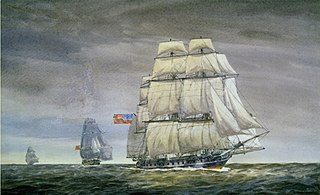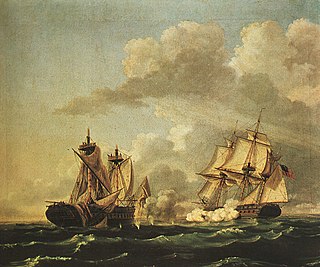
USS Adams was a 28-gun (rated) sailing frigate of the United States Navy. She was laid down in 1797 at New York City by John Jackson and William Sheffield and launched on 8 June 1799. Captain Richard Valentine Morris took command of the ship.

USS Boone (FFG-28) was the twentieth ship in the United States Navy's Oliver Hazard Perry-class of guided missile frigates.

The first USS Essex of the United States Navy was a 36-gun or 32-gun sailing frigate that participated in the Quasi-War with France, the First Barbary War, and in the War of 1812. The British captured her in 1814 and she then served as HMS Essex until sold at public auction on 6 June 1837.
USS Growler was a 112-ton sloop-of-war, armed with ten 18-pounders and one 6-pounder, during the War of 1812. The United States Navy purchased Growler on Lake Champlain in 1812. The British captured her in 1813 and renamed her HMS Chub or Chubb. The Americans recaptured her at the Battle of Lake Champlain. She was sold in 1815.
USS Eagle, was a ship which served in the United States Navy in 1813-1815. Originally a merchant sloop, she was purchased at Vergennes, Vermont on Lake Champlain in 1812 and fitted as either sloop of war or brig for naval service. The British captured her in 1813 and renamed her HMS Finch, only to lose her back to the Americans at the Battle of Lake Champlain in 1814. She was sold in 1815.
USS Sylph was a schooner in the United States Navy during the War of 1812.
Eighteen ships of the Royal Navy have borne the name HMS Eagle, after the eagle.

HMS Tonnant was an 80-gun ship of the line of the Royal Navy. She had previously been Tonnant of the French Navy and the lead ship of the Tonnant class. The British captured her in August 1793 during the Siege of Toulon but the French recaptured her when the siege was broken in December. Rear-Admiral Horatio Nelson captured her at Aboukir Bay off the coast of Egypt at the Battle of the Nile on 1 August 1798. She was taken into British service as HMS Tonnant. She went on to fight at the Battle of Trafalgar in 1805, during the Napoleonic Wars.

The capture of HMS Macedonian was a naval action fought near Madeira on 25 October 1812 between the heavy frigate USS United States, commanded by Stephen Decatur, and the frigate HMS Macedonian, under the command of John Surman Carden. The American vessel won the long bloody battle, capturing and bringing Macedonian back to the United States. It was the first British warship to ever be brought into an American harbor.

HMS Endymion was a 40-gun fifth rate that served in the French Revolutionary Wars, the Napoleonic Wars, the War of 1812 and during the First Opium War. She was built to the lines of the French prize Pomone captured in 1794. Due to her exceptional handling and sailing properties, the Severn-class frigates were built to her lines, although the gunports were rearranged to mount an extra pair of guns per side, the ships were made of softwood and were not built until nearly the end of the Napoleonic Wars.

HMS Linnet was a 16-gun brig, built in 1814 by the Royal Navy at Ile aux Noix, Canada, as Niagara. Renamed Linnet and commanded by Commander Daniel Pring, RN, she served on Lake Champlain during the War of 1812. The Americans captured her in 1814 at the Battle of Lake Champlain at Plattsburgh, New York, and took her into service though she never sailed again. She was sold in 1825.
USS Frolic was a sloop-of-war that served in the United States Navy in 1814. The British captured her later that year and she served in the Royal Navy in the Channel and the North Sea until she was broken up in 1819.
Ten ships of the Royal Navy have borne the name HMS Confiance:
Rear-Admiral Sir George Burlton KCB was an officer of the Royal Navy during the Napoleonic Wars.
HMS Nymphe was a 38-gun fifth rate frigate of the Royal Navy, launched on 13 April 1812 at Woolwich Dockyard, and commissioned later that month. She was a Lively class of 18-pounder frigates, designed by the Surveyor of the Navy, Sir William Rule. It was probably the most successful British frigate design of the Napoleonic Wars, to which fifteen more sister ships would be ordered between 1803 and 1812.






